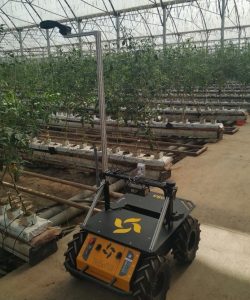Development of the device for measurement and mapping of nitrogen as the most important parameter in sustainable agriculture
Implementation period: 01/04/2016 - 31/07/2020
Type of Project: National
Project aim: This project focuses on multidisciplinary scientific research in the fields of micro and nanoelectronics, microfluidics, three-dimensional printing, optics, electronics, signal processing, information technologies, and robotics, to develop a unique system for measuring and mapping nitrogen as the most important parameter for sustainable agriculture, consisting of two components:
A) Devices for measuring the plant’s current nitrogen needs and
B) Devices for measuring and mapping the amount of nitrogen available in the soil.
About the project: According to the FAO and the United Nations, in the next thirty years, agriculture must produce about 70% more food than today, to feed the growing world population. The only answer to this burning issue is the use of modern technologies and the development of precise and sustainable agriculture, the efficiency of which will be increased, and the negative impact on the environment reduced.
Determining the amount of nitrogen as the most important parameter for plant growth and yield remains a huge challenge, as affordable and accurate devices for measuring and mapping nitrogen are virtually non-existent on the market. This problem is even greater if it is known that the amount of nitrogen and nitrogen compounds (primary nitrate) in the soil varies both spatially and in time. Precise knowledge of the current needs of the plant for nitrogen as well as the amount of nitrogen available in the soil at a given location and at a given time would enable spatially accurate and timely distribution of fertilizers, rather than uniform and time static as is the case today. In this way, not only the maximum yield will be ensured, but also significant economic savings by reducing the amount of fertilizer used will be achieved.
In addition to the economic, this approach brings great environmental benefits. Namely, the excess nitrogen from non-optimally applied nitrogen fertilizers is washed out from the soil and eventually reaches groundwater, rivers, and lakes where it causes algae blooms and oxygen depletion in the water, which harms the fauna.
This project proposes the development of two devices – one for determining the current needs of the plant for nitrogen, and the other for precise spatial and temporal mapping of the amount of nitrogen available in the soil. Together, these devices will, for the first time, make it possible to see the complex dynamics of nitrogen in crops and soil and form precise fertilizer distribution maps, which would increase yield, reduce agricultural production costs and minimize its negative environmental impact of nitrogen pollution. Both devices will be connected to a unique robotic system that will be developed in collaboration with a foreign partner in this DLO project, the University of Wageningen, the Netherlands, the world’s leading scientific institution in the field of precision agriculture.



Themes:
1) Microwave Soil Moisture Sensor
2) Agrobot for in-field soil analysis
3) Optical sensors
4) Plant-O-Meter - low-cost portable multispectral optical device for precise plant status assessment